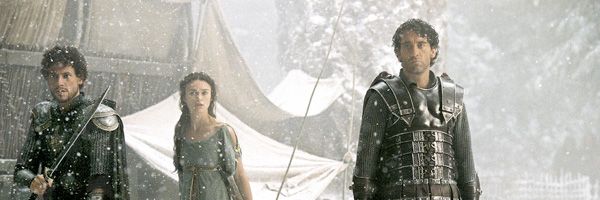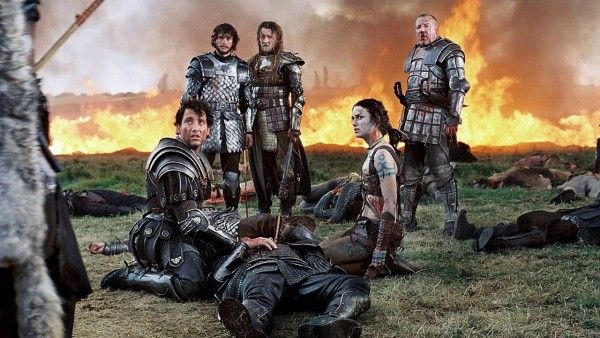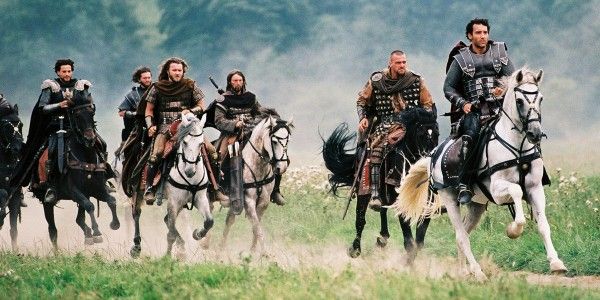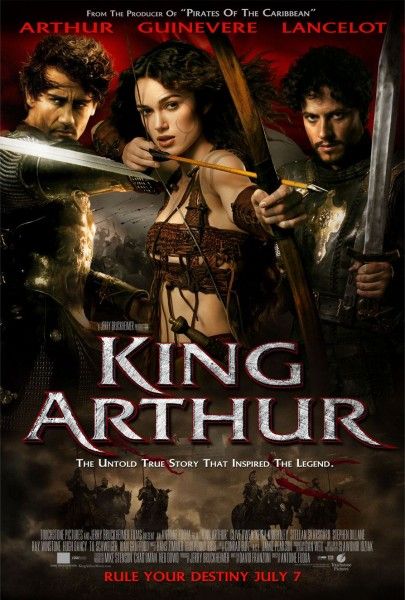This Friday, we’re getting a new King Arthur movie with Guy Ritchie’s King Arthur: Legend of the Sword. It’s the first King Arthur blockbuster since Antoine Fuqua’s disastrous 2004 film, King Arthur. That movie currently sits at 31% on Rotten Tomatoes and pulled in a pitiful $51 million at the domestic box office even though its reported budget was $120 million. To put that in perspective King Arthur grossed less domestically in 2004 than Without a Paddle, The Butterfly Effect, and White Chicks.
Where did it all go so wrong? It wasn’t with the cast. The movie boasts an impressive lineup of actors who have only become more famous over the years. There were rising stars Clive Owen and Keira Knightley, but the cast also includes Mads Mikkelsen, Hugh Dancy, and Joel Edgerton as well as reliable character actors like Stellan Skarsgard, Ray Winstone, and Til Schweiger. The only person whose fame has diminished is Ioan Gruffudd, whose Lancelot was clearly meant to be the protagonist until either executives or test audiences decided he was a black hole of charisma and changed the movie around.
Of course, no one in the movie really has much of a character. That’s one of the weirdest things about King Arthur—for all of its reliance on wanting to be “gritty and real” it has zero interest in creating characters who can carry the movie. The clear inspiration for the film is Gladiator, with which it shares a screenwriter (David Franzoni) and then leans heavily into the gritty combat. It’s like the filmmakers saw the opening scene of Gladiator and then left to make King Arthur, leaving out all of the character development that elevates it from being an average action film (also, Antoine Fuqua is no Ridley Scott).
You have this massive cast, and yet the movie provides almost no reason for caring about any of them. We know Arthur and his knights are pals, we know that they don’t want to keep fighting for Rome, we know that they’re on one last mission before they get the discharge papers they already earned fighting for the Empire for the last 15 years, and that there are some weird indigenous people represented by Merlin (Stephen Dillane) and Guinevere (Knightley). Eventually, there’s going to be a big battle with the Saxons, led by bad guy (*checks IMDb*) Cerdic (Skarsgard).
That’s a lot of actors to waste, and it’s made even more confusing by the fact that in a film that’s supposed to traffic in “gritty realism” (even though this is a film that would probably give a history professor fits), it has about as much time for its characters as a Transformers movie. This is a film that, because it decided to cut out all of the fantasy elements that usually surround the King Arthur myth like Merlin’s magic or the Sword in the Stone (Arthur gets his father’s sword from a burial mound in Fuqua’s film), you need to rely on characters.
If you can squint through the haze of meaningless battle scenes and paper-thin characters, you can kind of see a better version of this movie where it’s basically Seven Samurai set in Arthurian times. You have a group of fighters who are on one last mission, you know that not all of them are going to survive, and they nobly risk their lives to protect a small village. It’s not a terrible idea, although why you would need to do that with the King Arthur story is beyond me if you’re going to cut out the cool bits like wizardry, magic swords, and the love triangle between Arthur, Guinevere, and Lancelot.
It’s not surprising that the failure of this film basically tanked the King Arthur story theatrically for over a decade. It’s that bad and painfully dull. But by seeing how it avoids the interesting aspect of the King Arthur legend provides a roadmap for how others can do a better job of telling the story. The King Arthur myth has survived for centuries, and it will continue to survive whether or not Ritchie’s film is a success just as it did despite Fuqua’s film being a failure. But what 2004’s King Arthur taught us that if you’re going to dive into this myth and try to ground it in “reality”, the characters should be as believable as the setting rather than painting Keira Knightly blue, putting her in a leather bikini, and calling it a day.
On the plus side, the movie did give us this unintentionally hilarious moment:




